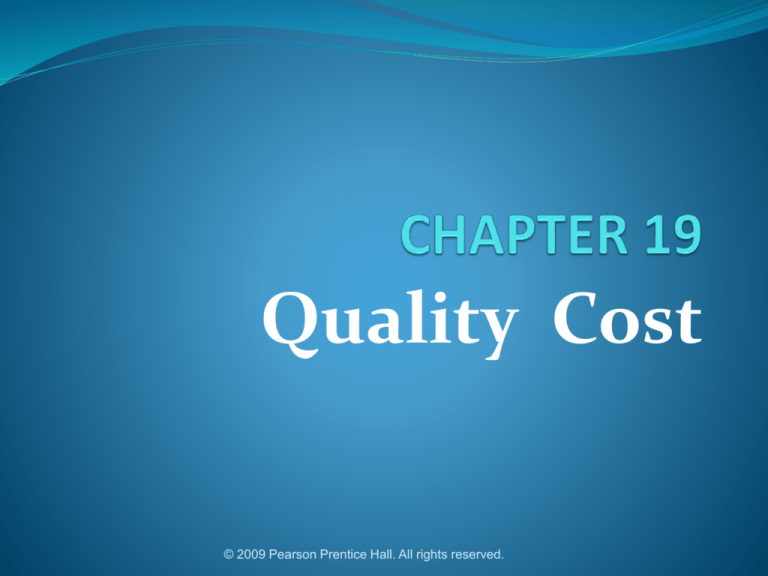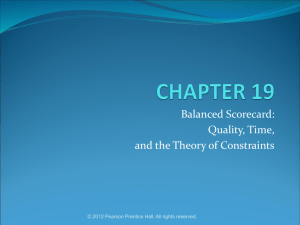
Quality Cost
© 2009 Pearson Prentice Hall. All rights reserved.
Quality as a Competitive Tool
Quality – the total features and
characteristics of a product or a
service made or performed
according to specifications to
satisfy customers at the time of
purchase and during use
A quality focus reduces costs and
increases customer satisfaction
© 2009 Pearson Prentice Hall. All rights reserved.
Quality as a Competitive Tool
Focusing on the quality of a
product will generally build
expertise in producing it, lower
the costs of making it, create
customer satisfaction for
customers using it, and generate
higher future revenues for the
company selling it
© 2009 Pearson Prentice Hall. All rights reserved.
Two Basic Aspects of Quality
1. Design Quality – refers to how
closely the characteristics of a
product or service meet the needs
and wants of customers
2. Conformance Quality – refers to the
performance of a product or service
relative to its design and product
specifications
© 2009 Pearson Prentice Hall. All rights reserved.
Quality and Failure
Actual
Performance
Design
Specifications
Conformance
Quality
Failure
Customer
Satisfaction
Design
Quality
Failure
© 2009 Pearson Prentice Hall. All rights reserved.
Four Perspectives of the
Balanced Scorecard
1. Financial
2. Customer
3. Internal Business
Process
4. Learning and Growth
© 2009 Pearson Prentice Hall. All rights reserved.
The Financial Perspective:
Costs
of Quality
(COQ)
Four
Categories
of Quality Costs:
Prevention Costs – incurred to preclude the
production of products that do not conform
to specifications
2. Appraisal Costs – incurred to detect which of
the individual units of products do not
conform to specifications
3. Internal Failure Costs – incurred on defective
products before they are shipped to
customers
4. External Failure Costs – incurred on defective
© 2009
Pearsonthey
Prentice Hall.
All rights
reserved.
products
after
are
shipped
to customers
1.
Elements of Costs of Quality
Reports
© 2009 Pearson Prentice Hall. All rights reserved.
Determining COQ using
Activity Based Costing
1. Identify the Chosen Product
2. Identify the Product’s Direct
Costs of Quality
3. Select the Cost-Allocation Bases
to Use for Allocating Indirect
Costs of Quality to the Product
© 2009 Pearson Prentice Hall. All rights reserved.
Determining COQ using
Activity Based Costing (cont)
4. Identify the Indirect Costs of
Quality Associated with each
Cost-Allocation Base
5. Compute the Rate per Unit of
Each Cost-Allocation Base Used
to Allocate Indirect Costs of
Quality to the Product
© 2009 Pearson Prentice Hall. All rights reserved.
Determining COQ using
Activity Based Costing (cont)
6. Compute the Indirect Costs
of Quality Allocated to the
Product
7. Compute the Total Costs of
Quality by Adding All Direct
and Indirect Costs of Quality
Assigned to the Product
© 2009 Pearson Prentice Hall. All rights reserved.
Activity-Based COG Analysis
Illustration
© 2009 Pearson Prentice Hall. All rights reserved.
Cost of Quality Exclusions
Opportunity Costs as a result from
poor quality:
1. Contribution Margin and Income
foregone from lost sales
2. Lost Production
3. Lower Prices
Excluded due to estimation
difficulties and being unrecorded as
to the financial accounting records
© 2009 Pearson Prentice Hall. All rights reserved.
The Learning & Growth Perspective for
Quality
Employee turnover ratio
Employee empowerment –
number of processes in which
employees have the right to make
decisions without consulting
supervisors
Employee Satisfaction
© 2009 Pearson Prentice Hall. All rights reserved.
Advantages of COQ (Financial) Measures
COQ focuses managers’ attention on the
costs of poor quality
COQ measures assist in problem solving
by comparing costs and benefits of
different quality-improvement
programs and setting priorities for cost
reduction
COQ provides a single, summary
measure of quality performance for
evaluating tradeoffs among the costs of
prevention, appraisal, internal failure
© 2009 Pearson Prentice Hall. All rights reserved.
Advantages of Nonfinancial Measures of
Quality
Nonfinancial measures of quality are
often easy to quantify and understand
Nonfinancial measures direct attention
to physical processes and to areas that
need improvement
Nonfinancial measures provide
immediate short-run feedback on
whether quality-improvement efforts
have succeeded
Nonfinancial measures are useful
indicators of future long-run
© 2009 Pearson Prentice Hall. All rights reserved.









